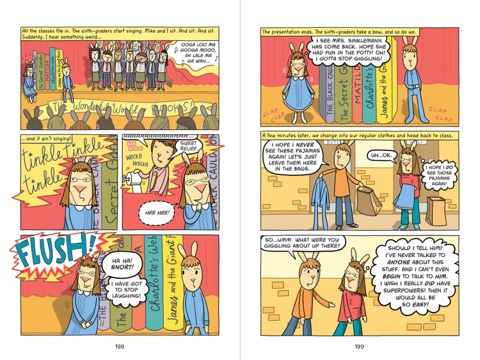I first read Walk Two
Moons by Sharon Creech when I was in fifth grade. A few classmates had read
and recommended it, and my mom had eventually bought it for me at a Scholastic
Book Fair, most likely after some relentless begging on my part. Walk Two Moons gave me my first
flashlight-under-the-covers experience as a child-- staying up late and unable
to stop turning pages, willing to suffer the tiredness that would follow the
next morning if it meant I could discover what happened to each beloved character.
Of course, as soon as I had turned the last page, my face became doused in
tears. Having recently lost my own grandmother to a stroke, I could relate to
the grandfather and granddaughter’s sorrow as they said goodbye to their dear
Gooseberry. That night as I dried my eyes with a Kleenex, my mother came in to
check on me.
“You okay, Pipe?” I remember her asking from my doorway, her
hair rumpled from sleep, an old t-shirt draped over her small shoulders.
I told her it was just my book, that
had a sad ending, but it was very good and that she would have to read it. She smiled,
told me she would, that she loved me, and we both went to sleep.
***
I remember splashing out of the pool, pulling my goggles off
of my eyes and onto my forehead, swiping the water off my face and onto the
deck, and plopping down on a towel in the chair next to my mother’s. She was leaning back in her reclining lawn
chair, a towel under her head, her skinny-framed sunglasses resting on her
nose. The sun shined down against my
mother’s black tan-kini, an attempt at covering the long scar that travelled
from her belly button to her chest line.
“Where are you? How many pages do
you have left?” I asked her, picking up her iced tea to have a sip.
“I’m close. They’re in the hospital.
It’s sad. I knew this was gonna happen.”
“You did?! I didn’t! I know, it is
sad. But it’s so good, isn’t it?!”
“Yeah it is. She’s an incredible writer,”
my mom declared. And with that, my twelve-year-old, skinny legs were running
back to the water to catch a tennis ball my brother had just thrown at me.
***
My mom and I had talked more about Walk Two Moons that night at dinner. I
remember it had made her sadder than I’d expected. I figured it was probably
because of Grandma Jean’s stroke, and Hida, my grandfather, being on this
vacation with us. When we got home from our trip, she had kept the book on her
nightstand for a while. She eventually put it back on the bookshelf in my
closet.
That’s where
I found it this fall.
***
I pulled up to campus, rushed and running a little later than
I would have liked, but grateful that I had at least found a parking lot next
to the building that would hold my class. Well,
I’m doing it, I thought as I walked up to the building after parking and
paying the ridiculous fee. I’m going to
grad school, like I thought I never would, Mom, like I always thought you were
so crazy for doing. But here I am doing it, and you aren’t here to see it.
I was bitter when I sat down. I tried to put those thoughts
aside and listen as my professor introduced herself and started to run through
the syllabus for my Children’s Literature class. She mentioned that for our
final we had a number of options, one of which was to read one of our favorite
books from our childhood and look back on it as an adult. She quoted Edmund
Wilson, saying “No two persons ever read the same book”. I liked this idea,
that a book would be different with each reading. I ran through the options, Because of Winn Dixie, The Series of
Unfortunate Events, Number the Stars, Holes. Somehow, from somewhere, Walk Two Moons came to mind. Oh! That would be a good one, I thought.
I remembered laughing as the main character told her grandparents about the
crazy next door neighbor and her first kiss. I remembered crying about the
grandmother’s stroke, but enjoying the book immensely. I decided it would work.
Class continued, and I left feeling a little bit better than I had when I’d
walked in. I would be able to do this. I would like this. My mom would have
been proud of me for doing it. Pulling out onto the road, I realized the lot I
was parked in was called “Holly”, my mother’s name.
***
I started
the book that night, choosing it over Motherless
Daughters or another New York Times article about grief. Little did I know,
it was about to be the best thing that helped me cope with losing my mother.
Thirteen-year-old Salamanca Tree Hiddle, who goes by Sal, would be someone I would
describe as “wise beyond her years” if she was a real person. And she seemed to
be just that—a real person. Sharon Creech’s development of each character makes
them so real that you cannot help but believe their every word, feeling, and
emotion. She brings her characters to life, making them friends you visit every
night before bed, or check in with over lunch. Creech, through Sal, makes the
reader laugh when she describes Phoebe’s father as “playing the role of Father,
with a capital F” (31), or mentions that her grandparents keep shouting,
“’Gol-dang!’” (70). They can feel Sal’s anger at her father for moving them to
Euclid, Ohio, and can understand her confusion surrounding her mother’s
departure: “When my mother first left for Lewiston, Idaho, that April, my first
thoughts were, ‘How could she do that? How could she leave me?’” (74). Every
word that Sal utters, the reader believes. As explained by James S. Jacobs and
Michael O. Tunnell in their textbook Children’s
Literature Briefly, “If a book is truly well written, the words between the
covers are arranged in almost magical patterns that stir deep emotional
responses in readers. The words do far more than relate the events of the
story. The words make the book by defining character, moving the plot along,
isolating theme, making the story believable” (22). Creech does all of these
things with her words.
The plot of this story also makes it
a quality book. Children who have not experienced grief first-hand can grasp to
the story Sal tells her grandparents as they travel: it is filled with mystery,
humor, and relatable characters. Sal tells her grandparents about her next door
neighbor Phoebe Winterbottom, whose mother goes missing for a couple days. Phoebe,
an anxious child, is convinced that a “lunatic” has kidnapped her mother,
despite the fact that her mother left a note stating that she’d return in a few
days, along with prepared meals in the refrigerator. The reader can’t wait to
figure out where Mrs. Winterbottom has gone and can’t help but find Phoebe’s
paranoia a bit comical, making this portion of the story completely
page-turning. While this part of the plot keeps the reader enchanted, the
reader also finds themselves concerned for, and curious about Sal’s inner
thoughts as she “prays to trees” along the drive (7). Sal feels rushed to
arrive in Lewiston before her mother’s birthday, although Sal and the reader
are unsure of her reasoning until the end of the book. This rushed feeling
reminds the reader that there is a bigger plot-line with deeper emotions to be
considered than just the entertaining story concerning Phoebe and Sal’s
schooldays in Ohio. Having this dynamic structure of a story within a story
makes the text more accessible and fascinating to children, young adults, and
grown adults.
Walk
Two Moons is also filled with unexpected insights tied to theme, another
quality of good children’s books, according to Tunnell and Jacobs. “We live
with characters as they work their way through problems, but may be delighted
suddenly by an eye-opening insight about the human experience that comes from
their struggles” (29). These insights were exactly what made this book so appealing
for me as a child, and so healing as an adult.
My mother had been treated for
Hodgkin’s Lymphoma when she was in her late twenties. In the 1980s, radiation
was considered the best treatment to burn these cancerous cells. Now, however,
doctors realize that these high amounts of radiation burn not only the
cancerous cells, but everything else around them. Throughout my childhood, my
mother had to go to the hospital: her pericardium was removed way before I came
into the picture, followed by her appendix, gall bladder, continued by thyroid
problems, sinus and ear problems, a knee surgery, a hip surgery, reactions to
medications causing extreme inflammation. Five-foot-six and a hundred pounds,
she looked tiny, but everyone knew she was fierce—she had the scars to prove it.
Unfortunately, the last surgery, one she knew she couldn’t avoid, was the
biggest one. She had two values replaced in her heart, another thing the
radiation had attacked. She fought and she fought, but she died four months
before I picked up Walk Two Moons.
Although Sal and I lost our mothers
in different ways, Creech’s approach and insight on grief was so authentic and spot-on,
that I feel it would be of great help to anyone, at any age, going through a
loss of a loved one. Sal’s feelings are so real, that most of the pages in my
copy of Walk Two Moons are now
dog-eared: reference points for me to go back to when my grief strikes up. Sal
describes her grief and all of its parts: anger, guilt, sadness, happiness, and
confusion.
“I was uneasy because everything that
happened at Phoebe’s that morning reminded me of when my mother left. For
weeks, my father and I fumbled around like ducks in a fit. Nothing was where it
was supposed to be. The house took a life of its own, hatching piles of dishes
and laundry and newspaper and dust. My father must have said ‘I’ll be jiggered’
three thousand times…. When my father said my mother was not coming back, I
refused to believe it. I brought all of her postcards down from my room and
said, ‘She wrote me all these, she must be coming back.’ And just like Phoebe,
who had waved her mother’s sweater in front of her father, I had brought a chicken
in from the coop: ‘Would Mom leave her favorite chicken?’ I demanded. ‘She
loves this chicken.’ What I really meant was, ‘How can she not come back to me?
She loves me’” (133-134).
And:
“As the days went on, many things
were harder and sadder, but some things were strangely easier. When my mother
had been there, I was like a mirror. If she was happy, I was happy. If she was
sad, I was sad. For the first few days after she left, I felt numb,
non-feeling. I didn’t know how to feel. I would find myself looking around for
her, to see what I might want to feel.
One day, about two weeks after she
had left, I was standing against the fence watching a newborn calf wobble on
its thin legs. It tripped and wobbled and swung its big head in my direction
and gave me a sweet, loving look. ‘Oh!’ I thought. ‘I am happy at this moment
in time!’ I was surprised I knew this all by myself, without my mother there.
And that night in bed, I did not cry. I said to myself, ‘Salamanca Tree Hiddle,
you can be happy without her.’ It seemed a mean thought, and I was sorry for
it, but it felt true” (38-39).
As I read Walk Two Moons after losing my mother, I
constantly thought, “So I’m not crazy! Someone else has felt this way! This is
normal!” It was amazing how a fictional book had the ability to contain these
“eye-opening insights”, something the non-fiction, technical, self-help books
had time and time again failed to do. I realized that having a fictional
middle-school-aged friend who understood was better than having the advice of
scientists and doctors.
***
One of my
favorite parts of Walk Two Moons happens close to the end. Sal remembers when her
dog, Moody Blue, had puppies. She mentions that initially following the birth
of the puppies, Moody Blue “kept her sharp eyes” on the puppies, “herding them
back”, but eventually, she starts snipping at the puppies and pushing them
away. Sal finds this behavior terrible and tells her mother how appalled she
is.
“’It’s normal. She’s weaning them
from her.’” Her mother tells her.
“’Does she have to do that? Why
can’t they stay with her?’”
“’It isn’t good for her or for them. They have to become
independent. What if something happened to Moody Blue? They wouldn’t know how
to survive without her.’” (258)
***
Now Walk Two Moons
rests on my nightstand, not my mother’s. I now understand why she had kept it
close to her bedside after losing her own mother. Her bookmark was still tucked
between its pages when I picked it up. I’d like to think it was her way of reminding
me what Moody Blue wanted her puppies to know: I have shown you how to do this
without me.
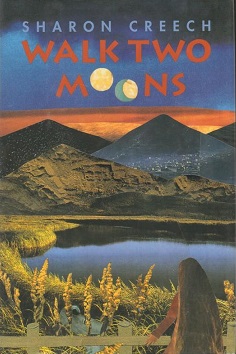 |
| Original Cover |
 |
| Paperback cover |
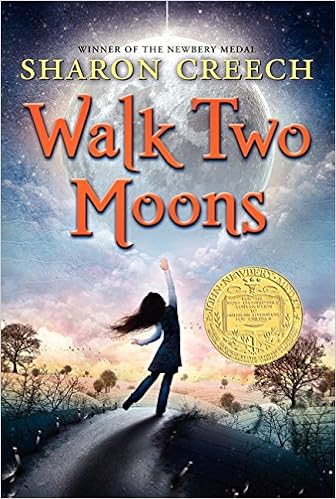 |
| Recent cover |



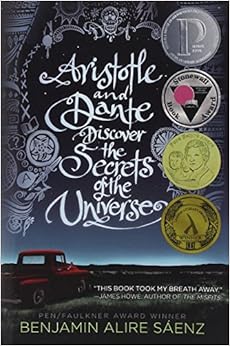








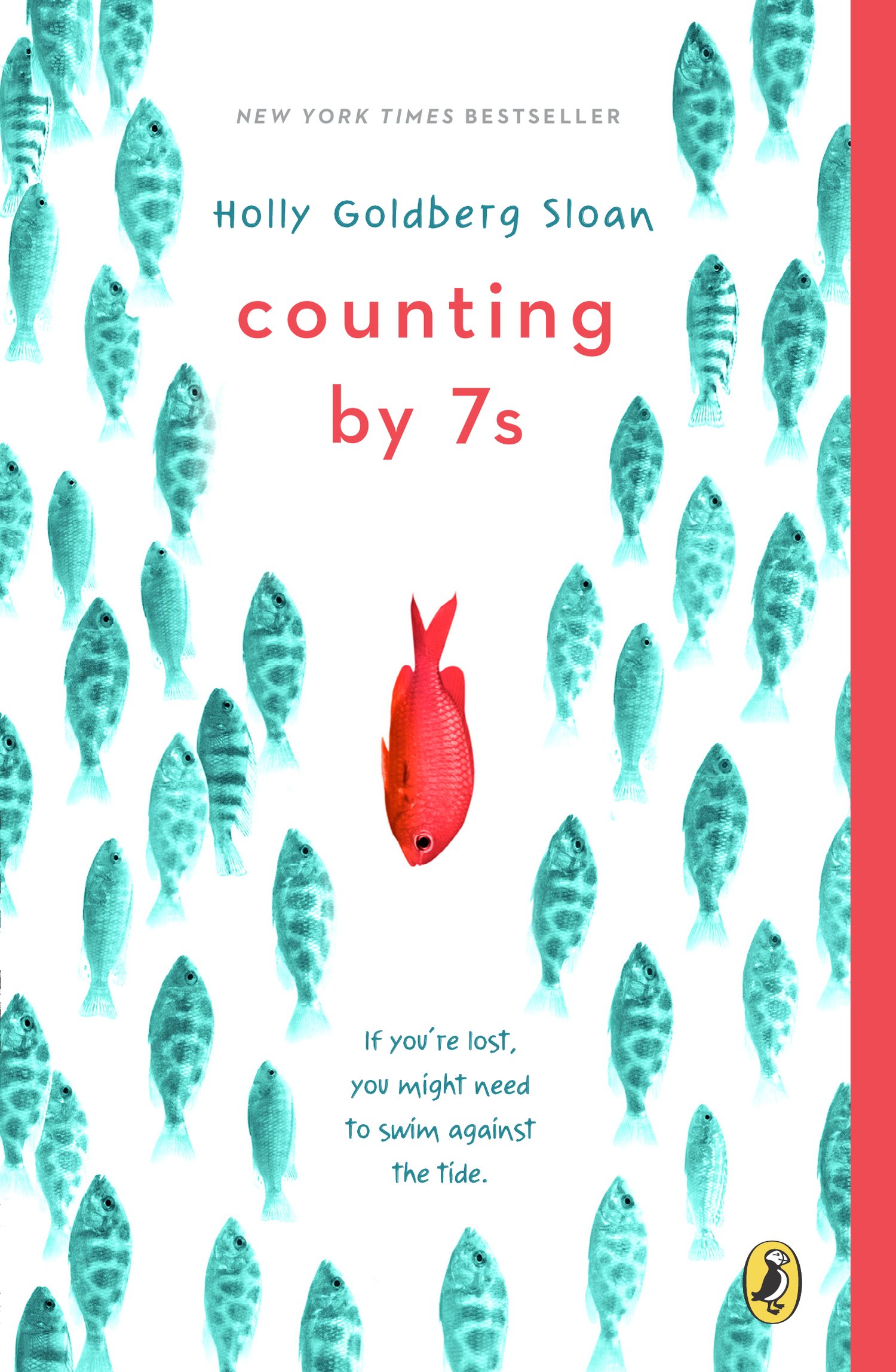
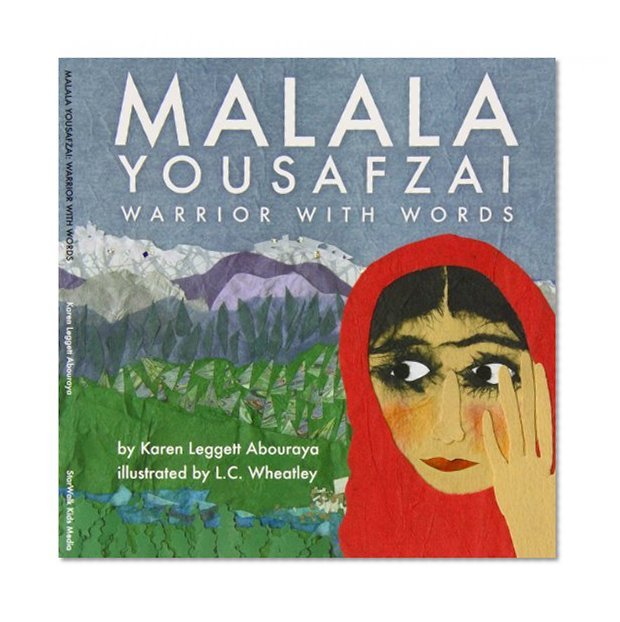


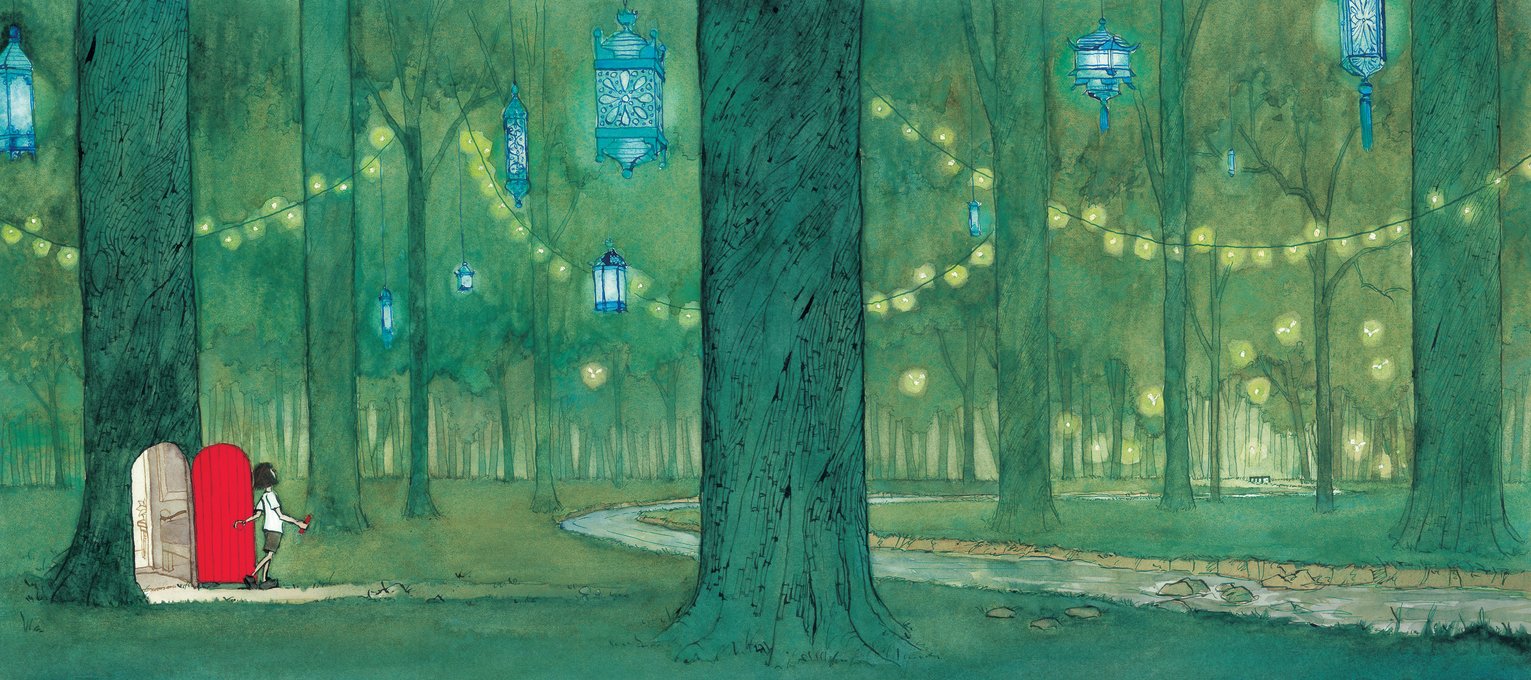

 Extra Yarn by Mac Barnett and illustrated by Jon Klassen is an adorable picture book about a kind little girl who knits colorful, warm sweaters and wraps for people and things in her town. The story starts with an illustration of a dark, snow-covered town that the author describes as "cold" and covered with "soot from chimneys". Annabelle, the main character, finds a small box of yarn. She knits herself a sweater, and then one for her dog, Mars. Afterwards, she still has extra yarn. Annabelle begins to sew for her neighbors, her family, her classmates and teacher, and the animals in her neighborhood. Two leafs of the book show the town still covered in snow, but now with colorful houses wearing sweaters. At one comical point, Annabelle is actually knitting a sweater for a pick-up truck. Later in the story, the evil archduke arrives to Annabelle's town, offering to pay a large sum of money for her ever-refilling box of yarn. She politely rejects his offer, leaving the archduke to steal the yarn box. However, once he steals the box, he realizes that it is empty. Enraged, the villian tosses the box into the ocean, shouting that the child will never be happy again. The story, nonetheless, ends on a happy note, with the box landing on Annabelle's shores, a smile on her face.
Extra Yarn by Mac Barnett and illustrated by Jon Klassen is an adorable picture book about a kind little girl who knits colorful, warm sweaters and wraps for people and things in her town. The story starts with an illustration of a dark, snow-covered town that the author describes as "cold" and covered with "soot from chimneys". Annabelle, the main character, finds a small box of yarn. She knits herself a sweater, and then one for her dog, Mars. Afterwards, she still has extra yarn. Annabelle begins to sew for her neighbors, her family, her classmates and teacher, and the animals in her neighborhood. Two leafs of the book show the town still covered in snow, but now with colorful houses wearing sweaters. At one comical point, Annabelle is actually knitting a sweater for a pick-up truck. Later in the story, the evil archduke arrives to Annabelle's town, offering to pay a large sum of money for her ever-refilling box of yarn. She politely rejects his offer, leaving the archduke to steal the yarn box. However, once he steals the box, he realizes that it is empty. Enraged, the villian tosses the box into the ocean, shouting that the child will never be happy again. The story, nonetheless, ends on a happy note, with the box landing on Annabelle's shores, a smile on her face.



